
The Nazca booby is a large seabird of the booby family, Sulidae, native to the eastern Pacific. First described by Walter Rothschild in 1902, it was long considered a subspecies of the masked booby until recognised as distinct genetically and behaviorally in 2002. It has a typical sulid body shape, with a long pointed orange-yellow bill, long neck, aerodynamic body, long slender wings and pointed tail. The adult is bright white with black and white wings, a black tail and a dark face mask.

Soemmerring's gazelle, also known as the Abyssinian mohr, is a gazelle species native to the Horn of Africa. The species was described and given its binomen by German physician Philipp Jakob Cretzschmar in 1828. Three subspecies are recognized. It is no longer present in Sudan.
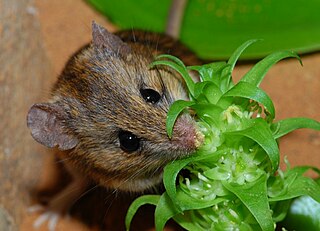
Aethomys is a genus of rodent from Africa. They are commonly referred to as rock rats, bush rats or rock mice.
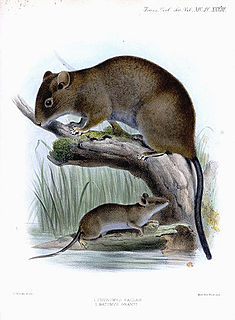
Batomys is a genus of rodent endemic to the Philippines. It has six described species.

Grant's gazelle is a species of gazelle distributed from northern Tanzania to South Sudan and Ethiopia, and from the Kenyan coast to Lake Victoria. Its Swahili name is swala granti. It was named for a 19th-century British explorer, Lt Col Grant.
Grant's rock mouse or Grant's rock rat is a species of rodent in the family Muridae found only in South Africa. It is sometimes included in the genus Micaelamys. Its natural habitats are subtropical or tropical dry shrubland and rocky areas.

The Luzon forest rat or Luzon hairy-tailed rat is one of five species of rodent in the genus Batomys. It is in the diverse family Muridae. This species is found only in the Philippines. This species was the first of the five to be identified and stayed the sole indicator for the genus for roughly 75 years, until 1988. Majority of this species lives on Mount Data which is one of several mountains in the Cordillera Mountains region of Northern Luzon.
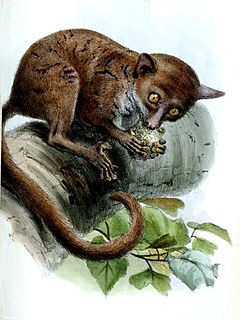
The western dwarf galagos are a group of three species of strepsirrhine primates, native to western and central Africa. They are classified in the genus Galagoides of the family Galagidae. The eastern dwarf galagos have been moved to their own genus, Paragalago, based on genetic evidence and differences in vocalization. The two genera are not sister taxa and thus may have evolved their small sizes via parallel evolution. They are separated by the East African Rift.
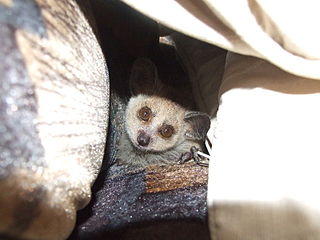
Grant's bushbaby, also known as Grant's lesser bushbaby or the Mozambique lesser bushbaby, is a species of primate in the family Galagidae. It is found in Malawi, Mozambique, Tanzania, and Zimbabwe. Its natural habitat is subtropical or tropical dry forests. It is a common species and the International Union for Conservation of Nature has assessed its conservation status as being of "least concern".

The forest shrews are the members of the genus Sylvisorex. They are mammals in the family Soricidae and are found only in Africa. The genus name comes from the Latin world "silva" which means "forest" and "sorex", which means "shrew-mouse". This reflects the nature of these shrews, which prefer forest habitats. All shrews are carnivorous, and eat continually to satisfy their high metabolic rate.

Grant's forest shrew is a species of mammal in the family Soricidae found in the mountain forests of central Democratic Republic of the Congo, Kenya, Rwanda, Tanzania, and Uganda. Its natural habitat is subtropical or tropical moist montane forests.
Erpetosuchus is an extinct genus of pseudosuchian from the Late Triassic. The type species of Erpetosuchus is E. granti. It was first described by E. T. Newton in 1894 for remains found in northeastern Scotland, including four specimens from the latest Carnian Lossiemouth Sandstone Formation. Additional remains of Erpetosuchus have been found in the New Haven Formation of Connecticut in the eastern United States, although they were not attributed to the species E. granti. The relationship of Erpetosuchus to other archosaurs is uncertain. In 2000 and 2002, it was considered a close relative of the group Crocodylomorpha, which includes living crocodylians and many extinct relatives. However, this relationship was questioned in a 2012 analysis that found the phylogenetic placement of Erpetosuchus to be very uncertain.
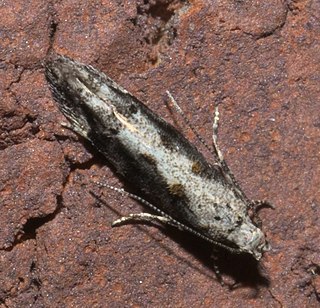
Coleotechnites is a genus of moths in the family Gelechiidae described by Vactor Tousey Chambers in 1880. One of the best known species is the lodgepole needle miner, a serious pest of forest trees in North America.
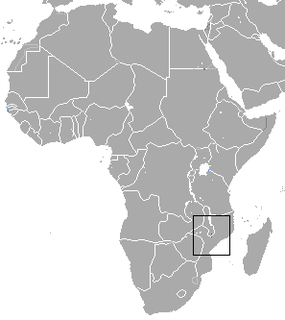
The Malawi bushbaby is a species of primate in the family Galagidae. It lives in southern Malawi and the neighboring region in Mozambique. The IUCN considers it to be part of the species Paragalago granti, Grant's bushbaby.

Schizaster is a genus of heart urchins belonging to the family Schizasteridae. The type species of the genus is Schizaster studeri.

Pseudochama is a species of bivalve mollusc in the family Chamidae.

Stenocoris is a genus of rice bugs in the family Alydidae. There are more than 20 described species in Stenocoris.

The eastern dwarf galagos are a group of seven species of strepsirrhine primates of the family Galagidae, native to East Africa. They were formerly classified in the genus Galagoides but have been moved to their own genus, Paragalago, based on genetic evidence, and supported by differences in vocalizations and morphology. The three western/Congolian species remain in Galagoides.

Leptocorisa is a genus of broad-headed bugs in the family Alydidae. There are about 17 described species in Leptocorisa, some of which are known as "rice bugs" or gundi bugs ; they are found in south and east Asia and in Oceania.

The Micrelytrinae are a subfamily of bugs in the family Alydidae, based on the type genus Micrelytra Laporte, 1833. Genera are recorded from the Americas, Europe and Asia.















